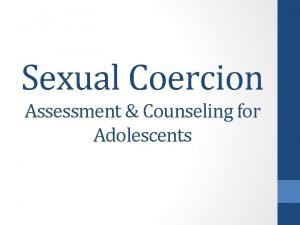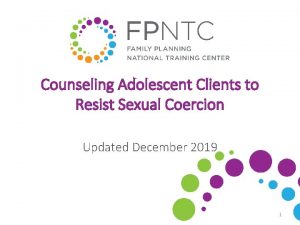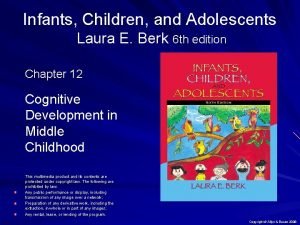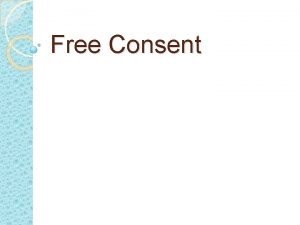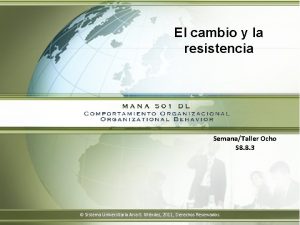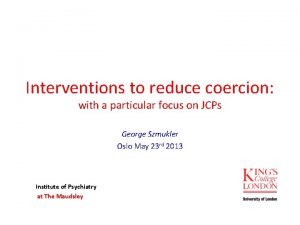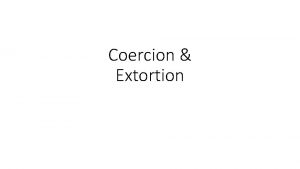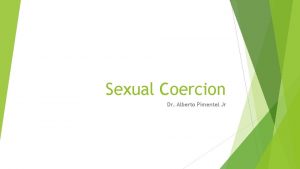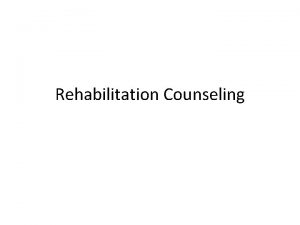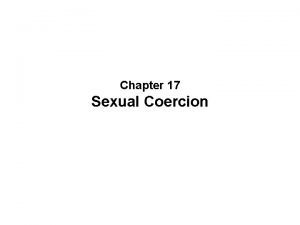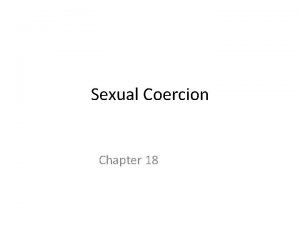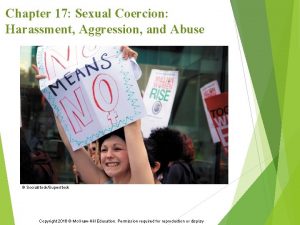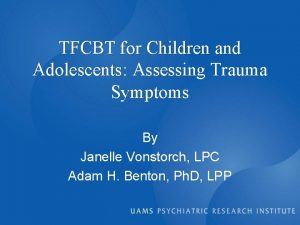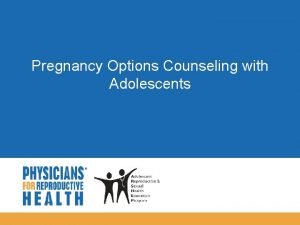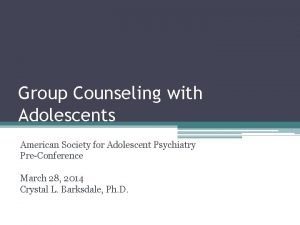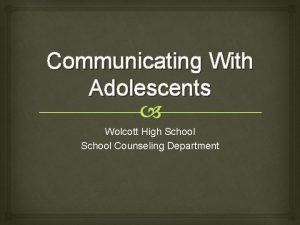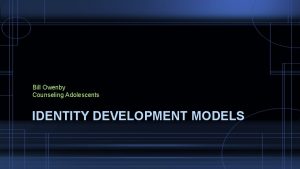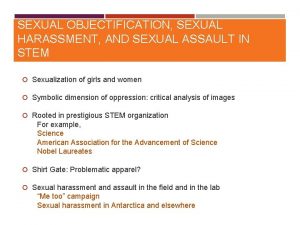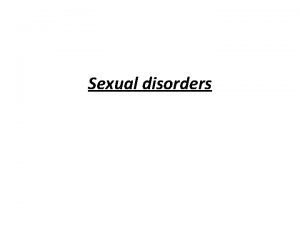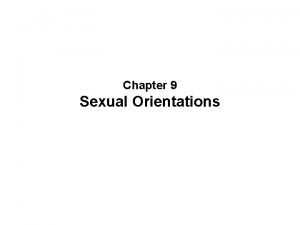Sexual Coercion Assessment Counseling for Adolescents Sexual Coercion




















- Slides: 20

Sexual Coercion Assessment & Counseling for Adolescents

Sexual Coercion • The act of persuading or coercing a minor into engaging in an unwanted sexual activity through physical force, threat of physical force, or emotional manipulation. • It differs from rape in that the coerced individual consents to the sexual activity for a variety of reasons. • The coerced individual feels it is easier to consent to sexual activity than decline due to an imbalance of power. • Coercive situations may not be obvious, even to the coerced individual.

Communicating with the Victim • Because of myths relating to sexuality and gender in our culture, many people do not recognize that the responsibility for avoiding sexual coercion is on those who prey upon young adolescents, not on the adolescents themselves. • Recognize that most important decisions are made unambiguously in an adolescents life. • Be aware of your assumptions and always respect the victim and make them feel safe. • Inform the victim that all information is confidential unless they disclose information about themselves or something else hurting them or are having thoughts of suicide. • Communicate what consent is in a relationship

Sexual Coercion • Many adolescents consent to sex without thinking they have a choice. • Adolescents spans a long time (ages 10 -24), not just teenagers • Coercive situations may use threats, humiliations, and anger as a means to convince a partner to consent to sexual behavior. • The coerced individual often agrees to the activity because he or she does not feel able to say “no” and have that response respected. Approximately one in three adolescent girls is a victim of physical, emotional or verbal abuse from a dating partner.

Types of Coercion • • • Threats: “I’ll tell everyone you’re a slut if you don’t do it” Bribes: “I’ll take you to the prom” Status: “Other girls would kill to go out with me” Flattery: “You’re so sexy, I thought you were at least 18” Intimidation: “No one will be able to hear you…. ” Nearly one in ten high-school students has been hit, slapped or physically hurt on purpose by a boyfriend or girlfriend.

Grooming Behaviors • Grooming techniques are used to first “test” a potential victim. If the techniques are rejected, the sexual predator may attempt to normalize the behavior and make it seem that the victim is the one that is acting out of character. • “I’m just trying to be friendly, don’t you like me? ? ” • Many grooming techniques align with normal, healthy dating behaviors.

4 Stages of Grooming 1. Testing: The sexual predator showers the potential victim with affection, attention, and time. The gestures will push the personal boundaries of the victim in numerous ways. 2. Desensitization: The predator will force the victim to accept the sexual advances by making them feel that the behavior is normal and should be accepted with open arms. • The victim’s reactions are minimized and often ignored; the predator will make the victim feel guilty and belittled.

Stages of Grooming 3. Isolation: The predator attempts to cut off the victim from sources of safety and support, such as friends and family members. 4. Control: Once the predator is successful in the attempt to coerce; tactics such as the following are used to maintain control: • • • Possessiveness Threats of self-harm Jealousy Gifts Playing on victims Constant presence

Factors Contributing to Sexual Coercion • Predators take advantage of the social factors which result in young women to feel insecure and submissive about their own sexuality. These factors include: • • • Focusing value on women’s sexual attractiveness and appeal Societies narrow definition of female beauty Media depiction of young women being sexually desirable Cultural standards of the type of women want to sleep with Cultural myth that younger adolescents should be sexually initiated by older peers

Risk Factors for Potential Sexual Coercion • Some adolescents are at a greater risk of being sexually coerced because of factors such as: • • • Being female Low self-esteem Attention craving qualities Low parental involvement Victims of bullying Mental or physical impairment Insecurity Victims of child sexual abuse Overly authoritarian parents Experiencing substance abuse

Risk Factors for Predators of Sexual Coercion • Individuals who are not confident about their ability to maintain a healthy relationship may turn to someone much younger as an ego boost • Men that hold rigid, stereotyped views of masculinity • Control issues • Victims of previous sexual abuse often become abusers. One in five teen girls electronically sent or posted nude/seminude photos or videos of themselves (12% of the girls said they felt ‘pressured’ to do so).

Recognizing Sexual Coercion and Sexual Exploitation • Anytime an adult has a sexual relationship with someone who is underage, it is a form of exploitation, even if no overtly coercive behavior appears to be involved. • The adult is using the sexual and emotional inexperience of the teen to get something form them. 1. The teen herself may no see the relationship as exploitive or coercive. 2. Many feel flattered that they are getting this affirmation of their attractiveness and maturity. 3. Even if the teen recognizes that the relationship is going too fast, or that it feels scary or uncomfortable, they will probably not express these feelings for fear of seeming “immature” or “unworthy” of the attention. 4. The exploiter will probably use grooming techniques to override resistance or objections on part of the young teen.

Consequences • If a potential sexual coercion has occurred and nothing is done about it, many negative health outcomes could occur such as: • • Development of borderline personality disorder Eating disorders and self mutilation Risk of STI and pregnancy Substance abuse Depression Suicide PTSD

Victim Blaming • Because of a lack of understanding about sexual assault and sexual coercion, sometimes the victim is the one blamed. • Because it is so difficult for us to discuss sexuality in our society, young people miss out on the information that is important to make such decisions as: • Setting and maintaining personal boundaries • How to be respectful in relationships • How to know if a relationship is healthy • Some phrases that are examples of victim blaming can include: • • “You should have known better” “Why did you go there? ” “Why did you let him…” Any “you should/shouldn’t” statements

What Does a Healthy Relationship Look like? • • • Based on shared values Consensual Non-exploitative Honest Pleasurable Protection against unintended pregnancies/STI’s

Preventing Sexual Coercion • Recognize the risk factors and coercive techniques. • Educational efforts need to be directed both at younger and older teens so they can learn to recognize coercive and grooming behaviors for what they are. • Education is key in prevention and it is important to be a trustworthy liaison that can connect the adolescent to help.

Successful Sexual Coercion Prevention • Most successful sexual coercion prevention programs tend to: • • Be peer facilitated Include education of boys and girls Include male and female facilitators Provide time for dialogue about gender roles and stereotypes together as a whole group as well as separated by gender Help adolescents identify what they want out of a relationship Give information about the law Include resources for hotlines and community sexual assault services Empower boys and girls to assert their wants and needs in a healthy way and how to bring that into a relationship

Things to Think About… • What are some approaches you have found helpful for opening communication when talking with adolescents? • In what ways can your workplace support you and make it easier for you to work with adolescents in these situations? • Imagine yourself as an adolescent victim… How would you react and how would you want others to react? One in four teens in a relationship report being called names, harassed, or put down by their partner via cell phone/texting.

Resources • National Domestic Violence Hotline • 1 -800 -799 -SAFE(7233) • Rape Abuse & Incest National Network (RAINN) Hotline • 1 -800 -656 -HOPE(4673) • City of Chicago Domestic Violence Helpline • 1 -877 -863 -6338 • National Organization for Victim’s Assistance • 1 -800 -879 -6682

Thank You! Created at the Edwardsville Regional office Illinois Department of Public Health
 What is coercion
What is coercion Sexual coercion meaning
Sexual coercion meaning What is the difference between courting and dating
What is the difference between courting and dating Berk 8th edition
Berk 8th edition Lara berk
Lara berk Que es un estado
Que es un estado Definicion de coercion
Definicion de coercion Definicion de coercion
Definicion de coercion Bala debi vs majumdar
Bala debi vs majumdar Modelo de cambio de robbins
Modelo de cambio de robbins Differential coercion theory
Differential coercion theory Stark
Stark Coercion
Coercion Fspos
Fspos Typiska drag för en novell
Typiska drag för en novell Tack för att ni lyssnade bild
Tack för att ni lyssnade bild Vad står k.r.å.k.a.n för
Vad står k.r.å.k.a.n för Varför kallas perioden 1918-1939 för mellankrigstiden
Varför kallas perioden 1918-1939 för mellankrigstiden En lathund för arbete med kontinuitetshantering
En lathund för arbete med kontinuitetshantering Adressändring ideell förening
Adressändring ideell förening Personlig tidbok för yrkesförare
Personlig tidbok för yrkesförare
